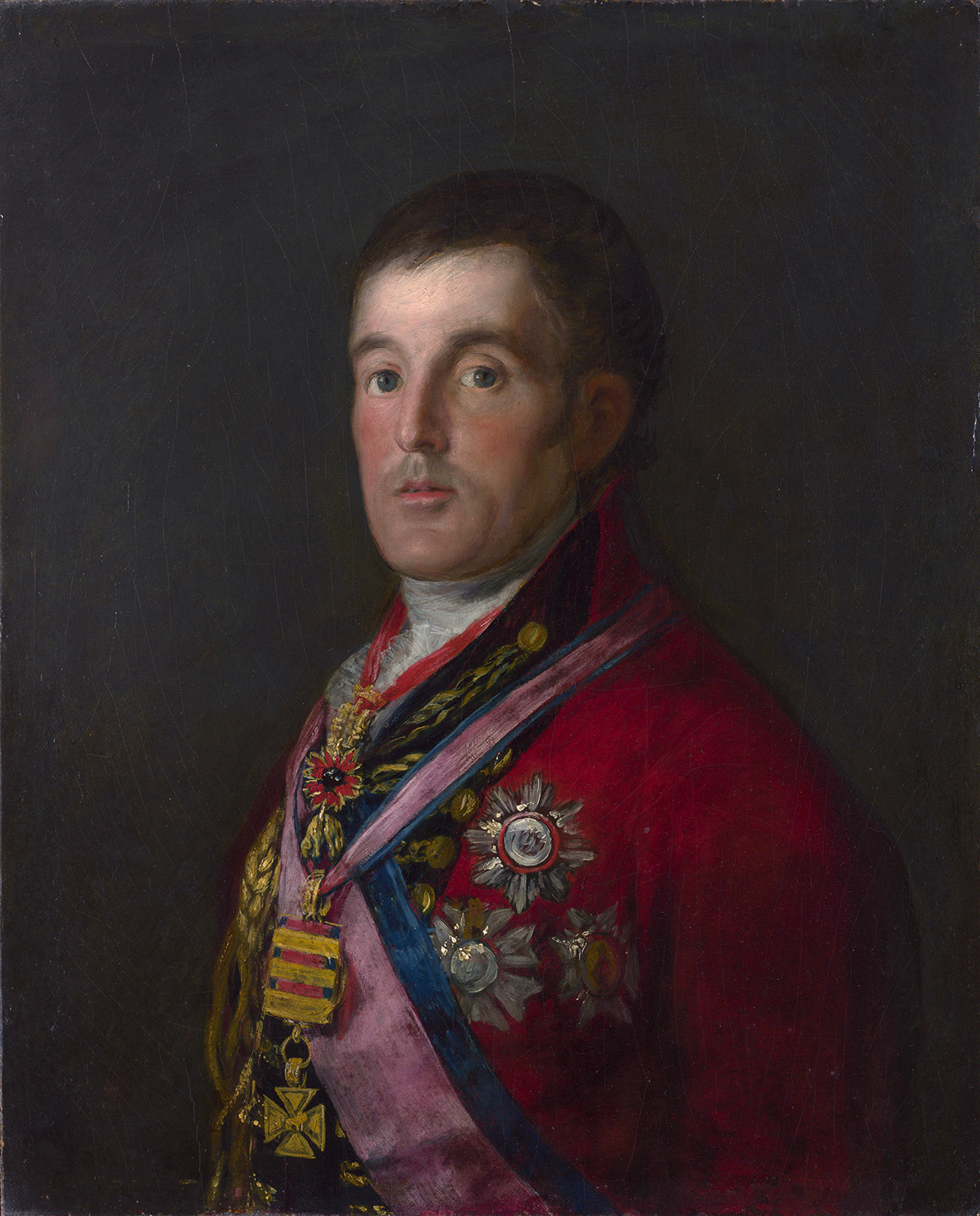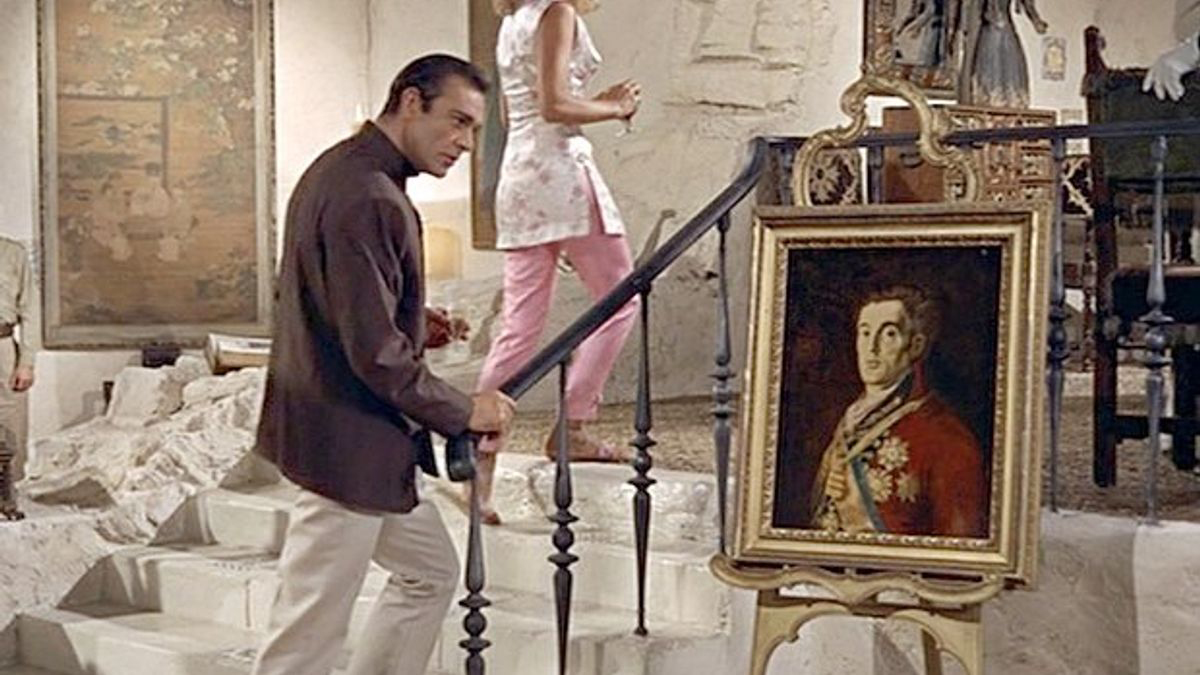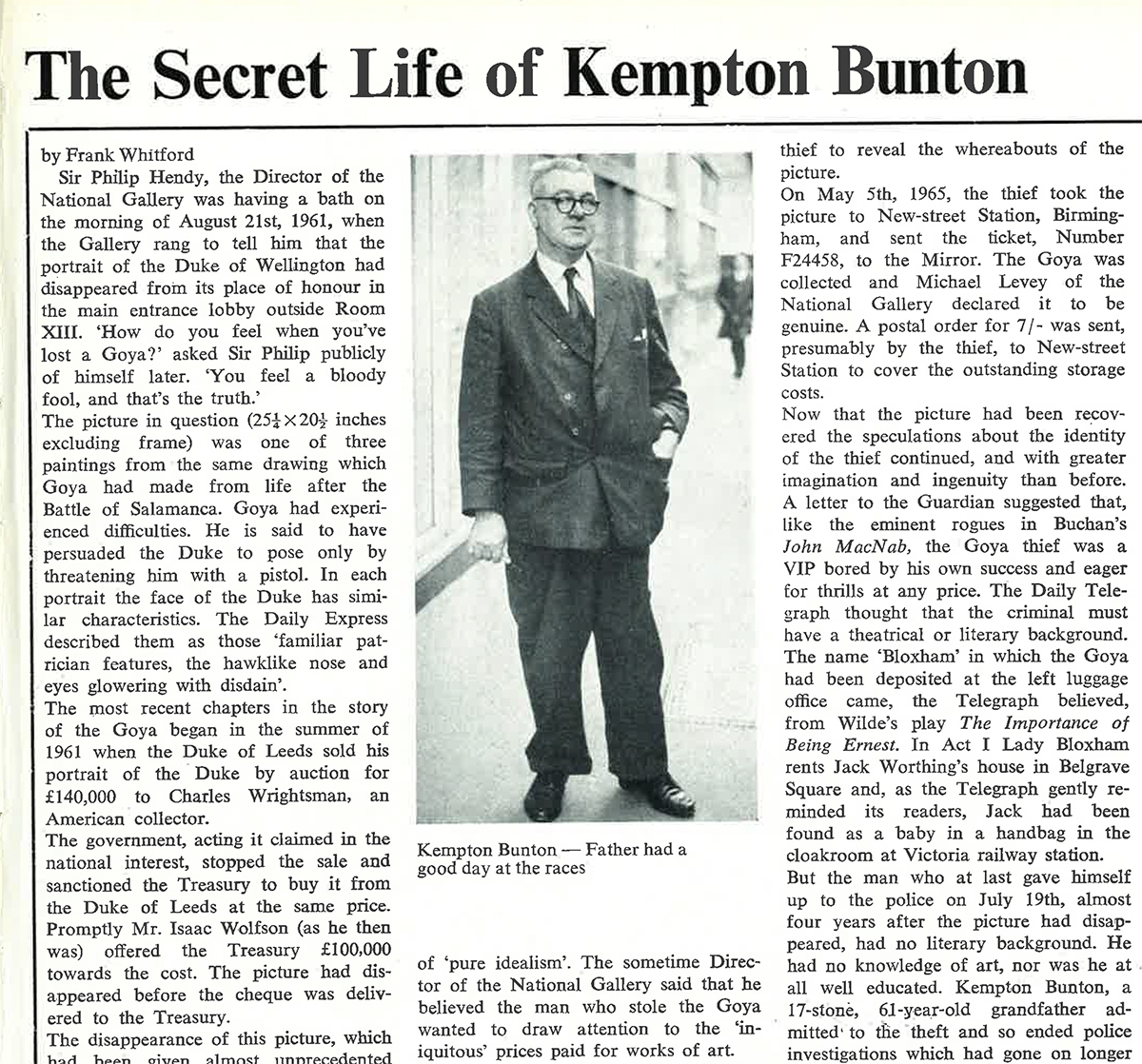In 1961, a painting of the Duke of Wellington by Goya was bought at auction from an English aristocrat by an American tycoon. After the government intervened to keep it in the UK, it was purchased and put on display in the National Gallery in London on 2 August. On 21 August, it was stolen. It did not reappear until four years later (bar a cameo in 1962’s Dr. No, in which Sean Connery’s James Bond pauses to admire the painting stashed away in the villain’s underwater lair.)
In 1965 Frank Whitford reported on the theft and the trial of the thief, for The Arts Review. It turned out that rather than being a glamorous and daring criminal aesthete, or an evil scientist in a subterranean hideout, the thief was a 61-year-old retired bus driver named Kempton Bunton. He had stolen the painting as a protest against the imposition of the BBC’s TV license fee on pensioners.
Art is often accused of being the preserve of wealth and exclusivity. On occasion, ordinary people protest against this. The National Gallery reopens this week after more than 100 days of closure due to COVID-19; Goya’s portrait of Wellington is still on display. Meanwhile, the BBC has yet to decide whether to scrap the previous concession of free TV licenses for the over-75s, under intense pressure from pensioners and their supporters…
Sir Philip Hendy, the Director of the National Gallery was having a bath on the morning of 21 August 1961, when the Gallery rang to tell him that the portrait of the Duke of Wellington had disappeared from its place of honour in the main entrance lobby outside Room XIII. ‘How do you feel when you’ve lost a Goya?’ asked Sir Philip publicly of himself later. ‘You feel a bloody fool, and that’s the truth.’
The picture in question (25 1/4 x 20 1/2 inches excluding frame) was one of three paintings from the same drawing which Goya had made from life after the Battle of Salamanca. Goya had experienced difficulties. He is said to have persuaded the Duke to pose only by threatening him with a pistol. In each portrait the face of the Duke has similar characteristics. The Daily Express described them as those ‘familiar patrician features, the hawklike nose and eyes glowering with disdain’.

The most recent chapters in the story of the Goya began in the summer of 1961 when the Duke of Leeds sold his portrait of the Duke by auction for £140,000 to Charles Wrightsman, an American collector.
The government, acting it claimed in the national interest, stopped the sale and sanctioned the Treasury to buy it from the Duke of Leeds at the same price. Promptly Mr. Isaac Wolfson (as he then was) offered the Treasury £100,000 towards the cost. The picture had disappeared before the cheque was delivered to the Treasury.
The disappearance of this picture, which had been given almost unprecedented publicity in the press, turned out to be the most spectacular art robbery of the century. During the early hours of 21 August, guards had noticed that the Goya had gone, but assumed that it had been taken for official reasons. It was not until the Gallery had opened to the public that it was fully realised that the picture had been stolen.
This, the first theft from the National Gallery for 138 years, immediately gave rise to a sustained burst of speculation. It was suggested that the theft had been carried out to celebrate the most sensational art robbery of all time: for the Duke had disappeared from his easel fifty years – almost to the minute – after Vincenzo Perugia had repatriated the Mona Lisa to Italy from the Louvre in August 1911.
The disappearance of the Goya followed a series of international art thefts, some of great daring, which started rumours about a millionaire who was secretly amassing a hoard of great masterpieces which he could contemplate only in the strictest isolation and privacy.
Some newspapers, giving weight to the theory that there was a dangerous gang of outstanding initiative at work, named names and left their readers to draw their own conclusion. One name was Giovanni Pilisi, an Italian dandy, who was said to have been connected with a group of high class Riviera criminals led by a Frenchman known as Pierrot the Fool.

With every paragraph of publicity, with every sentence of speculation, numbers of visitors to the National Gallery increased. More went to see the empty space than had been to see the painting, and Sir Kenneth Clark announced that the theft had been carried out in a spirit of ‘pure idealism’. The sometime Director of the National Gallery said that he believed the man who stole the Goya wanted to draw attention to the ‘iniquitous’ prices paid for works of art. Whoever took it, whoever he was, was certainly clever. He had breached one of the finest security systems in the country, had managed to elude elaborate and highly sophisticated electronic devices, and had avoided a night security guard of five men whose patrol routes took them close to the Goya every twenty minutes. No window or door had been tampered with and no clues of any sort had been found.
No wonder then, when the speculation progressed with even more fire and imagination. It was suggested, for example, that the theft had been sponsored by fanatical opponents of the gallery’s picture-cleaning policy, and that the thief showed the sort of enterprise which could only have come from training as a paratrooper with the Special Air Service during the war.
Lord Robbins, Chairman of the National Gallery Trustees, received thousands of letters about the theft, many of them lunatic. One said: ‘There is one man who can tell you who had the Goya, and that is Canon Collins’.
The Goya affair became even more controversial when Sir Gerald Kelly, President of the Royal Academy, and a man with a reputation for controversy, suggested that the portrait was not by Goya at all. In an interview with the Daily Express on 1 February 1964, he said: ‘We should have whooped with joy when it disappeared. I for one certainly hope that it will never be recovered.’ Meanwhile the police were making no progress. Ransom notes appeared at apparently carefully calculated intervals, and hoaxes were embarrassingly frequent. Nothing of any real value emerged until at the beginning of this year the Editor of the Daily Mirror organised a campaign to persuade the thief to reveal the whereabouts of the picture.
On 5 May 1965, the thief took the picture to New Street Station, Birmingham, and sent the ticket, Number F24458, to the Mirror. The Goya was collected and Michael Levey of the National Gallery declared it to be genuine. A postal order for 7/- was sent, presumably by the thief, to New Street Station to cover the outstanding storage costs.
Now that the picture had been recovered the speculations about the identity of the thief continued, and with greater imagination and ingenuity than before. A letter to the Guardian suggested that, like the eminent rogues in Buchan’s John MacNab, the Goya thief was a VIP bored by his own success and eager for thrills at any price. The Daily Telegraph thought that the criminal must have a theatrical or literary background. The name ‘Bloxham’ in which the Goya had been deposited at the left luggage office came, the Telegraph believed, from Wilde’s play The Importance of Being Ernest. In Act I Lady Bloxham rents Jack Worthing’s house in Belgrave Square and, as the Telegraph gently reminded its readers, Jack had been found as a baby in a handbag in the cloakroom at Victoria railway station.
But the man who at last gave himself up to the police on 19 July, almost four years after the picture had disappeared, had no literary background. He had no knowledge of art, nor was he at all well educated. Kempton Bunton, a 17-stone, 61-year-old grandfather admitted to the theft and so ended police investigations which had gone on longer than all others. During four years of enquiries, clues and theories, no line of suspicion had linked the stolen portrait with the 61-year-old lorry driver who had been unemployed for many months. Moon-faced, with crew-cut grey hair, Bunton (called Kempton after his father had enjoyed a good day at the races) lives at Yewcroft Avenue, Newcastle-upon-Tyne, and is well known in the area as a somewhat eccentric campaigner for civil liberties. In 1960 he was in gaol for a total of 69 days for refusing to pay for a TV licence, even though he had adapted his set to receive only the ITV, a theoretically free service. He now told the police that he had stolen the Goya to draw attention to his campaign for cheap TV licences for Old Age Pensioners. He had done the deed in a spirit of ‘honest-to-goodness skulduggery’, he claimed, and his intentions were anything but criminal.

In a statement, Bunton said that he had gained access to the gallery by using a builder’s ladder. He had climbed in through a lavatory window. He stole the portrait at 5.50 a.m., when the guards must have been asleep or playing cards. With the Duke of Wellington underneath his arm he climbed out of the same window and took the picture to his temporary lodgings near Kings Cross.
After leaving the frame somewhere in London, Bunton returned home. He put the picture at the back of his wardrobe. It was there for almost four years and Bunton kept the secret to himself. He never even told his wife: ‘If I had done’, he said, ‘the whole world would have known about it’. He gave himself up to the police only after he had let something slip to a friend one night in a pub. He gave himself into custody to prevent the friend telling the police and so claiming the considerable reward money.
The trial at the Central Criminal Court proved as interesting a revelation of English attitudes as the history of the affair itself had done. Doubts about the authenticity of the picture were brought up and the prosecuting lawyer suggested that Bunton had a ‘power complex’ and was a man who would not shrink from the consequences of power if he could obtain it.
What emerged was, that it is not a crime in law to remove a picture from an art gallery provided there is no intention of keeping it permanently. Bunton, who pleaded not guilty to each of the four charges that were brought against him, was convicted of only one. He was acquitted of stealing the painting, acquitted of two charges of demanding money with menaces, acquitted of causing a public nuisance. He was found guilty, however, of stealing the picture-frame – valued at £100 – which may now be in a cupboard under the stairs in a lodging house near Kings Cross or may be somewhere at the bottom of the Thames. He was jailed for three months, and before he was driven away to serve his sentence in Wandsworth Jail he said ‘I am intrigued by the verdict’.
Bunton’s sentence leaves many questions unanswered. His statement that he simply climbed in through a window and removed the painting at ten to six in the morning poses more problems than it solves. At that time the alarm system was apparently working, and the police had claimed that, after a close examination, no windows had been tampered with. Was the fiftieth anniversary of the theft of the Mona Lisa from the Louvre a mere coincidence, and was Bunton, an elderly man of seventeen stone, able to carry the picture out of the gallery without noise and difficulty?
The real irony of the story is that the National Gallery never wanted the portrait in the first place. For seventeen years it had been exhibited in the National Portrait Gallery on loan from the Duke of Leeds without comment and without publicity in the press. The National Gallery would have been happy to see it returned there. The Treasury, having bought it on the Government’s instructions, forced it on the National Gallery, and, it is said, the Gallery resented the Treasury meddling in its affairs.
There is no doubt that the National Gallery portrait is a minor work. The equestrian portrait at Apsley House is unquestionably finer, and while crowds flocked to see the Goya, Apsley House entertains, on average, a mere 150 visitors a day.
Meanwhile the Goya is not on show. It has been removed to the Gallery’s technology department for some minor repairs. When it does reappear, Sir Philip Hendy, who twice offered to resign over it, has plans for showing it together with the equestrian portrait and the original drawing now in the print room of the British Museum. In this way one aspect of the Goya mystery may finally be resolved – its authenticity.
The National Gallery in London will reopen on 8 July 2020. Visits can be prebooked here.